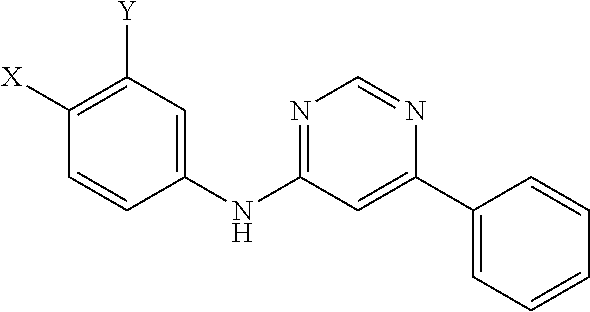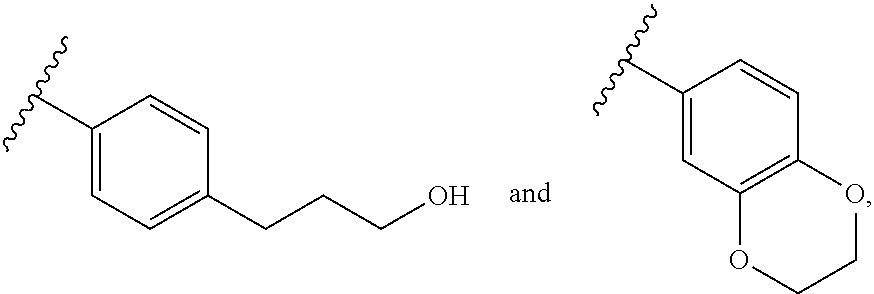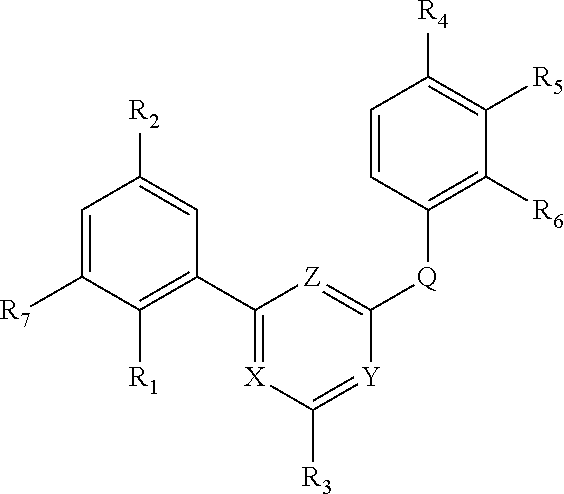Novel 4,6-disubstituted aminopyrimidine derivatives having both aromatic and halogenic substituents
a technology of aminopyrimidine and substituted aminopyrimidine, which is applied in the field of new 4, 6disubstituted aminopyrimidine derivatives, can solve the problems that the evidence of anti-hiv activity is not very convincing, and achieve the effects of reducing viral load, reducing inflammation and/or hyperactivation of immune system, and reducing viral infection
- Summary
- Abstract
- Description
- Claims
- Application Information
AI Technical Summary
Benefits of technology
Problems solved by technology
Method used
Image
Examples
example 32
Step 1
[0266]
[0267]14.898 g 4,6-Dichloropyrimidine (100 mmol) was dissolved in 600 ml 1,2-dimethoxyethane and the flask was filled with argon properly. 2.311 g Tetrakis(thriphenylphosphine) palladium[0] (2 mmol) was added and the mixture was stirred at room temperature for 30 minutes. Then 15.196 g 2-methoxyphenyl-boronic acid (100 mmol), 31.80 g anhydrous Na2CO3 (300 mmol) and 150 ml water was added under argon atmosphere. The mixture was heated to reflux temperature during 2 hours and was refluxed for additional 2 hours. The reaction mixture was poured to 1000 ml cold water and it was extracted three times with 200-200 ml of ethyl acetate. The combined organic layer was washed with brine, dried over MgSO4, decolorized with activated carbon and evaporated under reduced pressure. The residue was purified by column chromatography eluting with 25% ethyl acetate in hexanes. Fractions were evaporated to dryness and the residue was filtered from hexanes to get the pure product as a white ...
example 26
[0270]
[0271]226 mg 2-Methoxy-5-(6-(2-methoxyphenyl)pyrimidin-4-ylamino)phenol (obtained in Example 32, Step 2) (0.7 mmol) was dissolved in 10 ml N,N-dimethylformamide and cooled to 0° C. 79 mg KOtBu (0.7 mmol) was added and stirred for half an hour. 95 μl Pivaloyl chloride was added and it was stirred at room temperature overnight. Reaction mixture was poured onto 50 g ice and 1 ml saturated Na2CO3 solution was added. It was stirred until ice melts and then the precipitated solid was filtered off, washed well with water. Crude product was recrystallized from a minimal amount of acetonitrile, washed with diethyl ether and air-dried. Yield: 156 mg (55%). Ret. time: 3.01 min., (M+H)+=408, (M+H)−=406; 1HNMR (DMSO-d6, 300 MHz), δ (ppm): 9.52 (s, 1H), 8.65 (s, 1H), 7.95 (d, J=6.15 Hz, 1H), 7.50 (s, 1H), 7.43 (d, J=8.01 Hz, 1H), 7.38 (m, 2H), 7.17 (d, J=8.01 Hz, 1H), 7.09 (m, 2H), 3.89 (s, 3H), 3.74 (s, 3H), 1.31 (s, 9H).
4-Methoxy-N1-(6-(2-methoxyphenyl)pyrimidin-4-yl)benzene-1,3-diamine
example 41
Step 1
[0272]
[0273]3.45 g Sodium (150 mmol) was dissolved in 250 ml methanol and 15.612 g 4-fluoro-3-nitroaniline (100 mmol) was added in one portion. The mixture was refluxed for 3 days. It was evaporated under reduced pressure and 400 ml water was added. Mixture was extracted three times with 150-150 ml ethyl acetate. The combined organic layer was washed with brine, dried over MgSO4 and evaporated to 100 ml. After cooling it to 0° C. 40 ml ethyl acetate saturated with HCl gas was added and it was stirred at this temperature for 30 minutes. The precipitated solid was filtered off, washed well with ethyl acetate, diethyl ether and dried in vacuum desiccator over P2O5. Product was used directly in the subsequent step without any further purification. Yield: 19.51 g (95%). Ret. time: 1.43 min., (M+H)+=169, (M+H)−=167.
Step 2
[0274]
[0275]5.115 g 4-Methoxy-3-nitro-phenyl-ammonium chloride (obtained in Step 1) (25 mmol) was added to a solution of 5.517 g 4-chloro-6-(2-methoxy-phenyl)-pyrim...
PUM
| Property | Measurement | Unit |
|---|---|---|
| pH | aaaaa | aaaaa |
| temperature | aaaaa | aaaaa |
| temperature | aaaaa | aaaaa |
Abstract
Description
Claims
Application Information
 Login to View More
Login to View More - R&D
- Intellectual Property
- Life Sciences
- Materials
- Tech Scout
- Unparalleled Data Quality
- Higher Quality Content
- 60% Fewer Hallucinations
Browse by: Latest US Patents, China's latest patents, Technical Efficacy Thesaurus, Application Domain, Technology Topic, Popular Technical Reports.
© 2025 PatSnap. All rights reserved.Legal|Privacy policy|Modern Slavery Act Transparency Statement|Sitemap|About US| Contact US: help@patsnap.com



